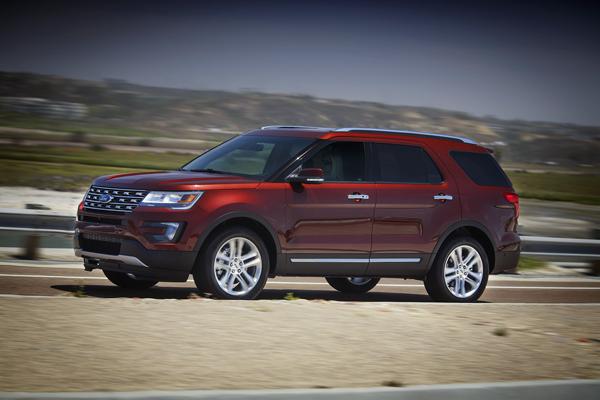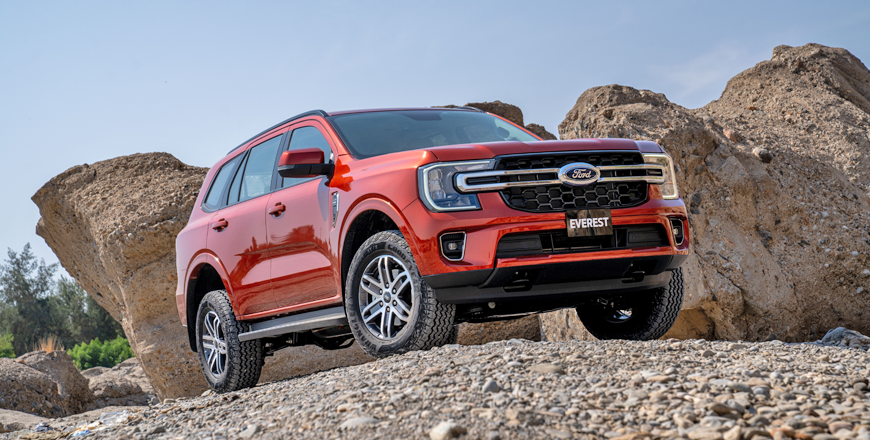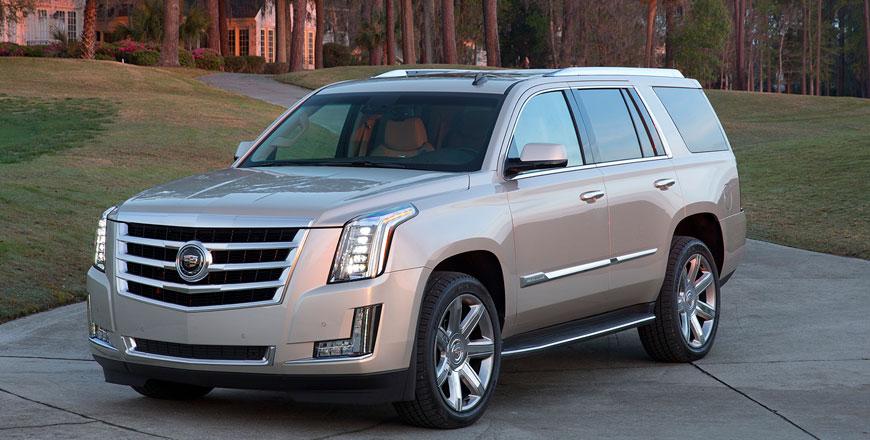You are here
Ford Explorer Limited 4x4: Rugged, refined and revised
By Ghaith Madadha - Jul 25,2016 - Last updated at Jul 25,2016

Photo courtesy of Ford
First launched in 2011 after a long line of traditional body-on-frame SUVs since 1990, the fifth generation Ford Explorer is a uni-body SUV better reflecting contemporary trends for more spacious, economical and refined road-biased vehicles. Updated for 2016, the Explorer receives new technology and equipment, and a more upmarket and rugged design facelift.
Winner of the 2016 Middle East Car of the Year’s Best Midsize SUV award, the revised Explorer is offered with four engine choices depending on market, including two turbocharged 4-cylinder units. The Middle East receives a 3.5-litre V6, twin-turbocharged for the Explorer Sport and naturally aspirated for other models, including the next-to range-topping Explorer Limited, as tested.
Sculpted SUV
Longer and more spacious than its predecessors, the current generation 7-seat Explorer is a more design-led product, with sculpted bodywork, well-integrated shape and blacked-out pillars apart from a reverse angle C-pillar lending a sense of urgency. Revised for 2016, the Explorer’s previous three-slat grille is replaced with a perforated and upscale higher-set design, flanked by sharper LED front headlights and new rear lights, replacing a trend-setting wraparound design. It also received a new spoiler for better aerodynamics.
The Explorer is built on a uni-body frame with all-round independent suspension and transverse layout, with the engine driving the front wheels and its four-wheel drive system allocating power rearwards as required. Though not designed as a dedicated off-roader, the Explorer’s intelligent four-wheel drive monitors conditions and reacts to prevent slip, and with selectable multi-mode Terrain Management System, leverages the anti-lock brakes to manage power allocation, prevent slip and effectively simulate differential locks to maintain traction.
Smooth and responsive
Smooth and refined, the Explorer Limited’s naturally aspirated 3.5-litre V6 engine is of an oversquare that is progressive in delivery and eager to rev towards its redline. Developing 255lb/ft torque at 4,000rpm and 290BHP by 6,500rpm, the Explorer’s engine is responsive and with four-wheel traction, carries its 2101kg mass confidently off-the-line. While 0-100km/h acceleration is undisclosed in press material, one roughly estimates this to be about 8 seconds, while top speed is likely restricted to about 180km/h.
High-revving and eager, the Explorer’s engine is satisfyingly long-legged and consistently confident as it build up torque and transitions to power accumulation through gears. Responsive and smooth, its six-speed automatic gearbox features a short first gear ratio for responsive acceleration and in lieu of low gear ratios for off-road driving. Meanwhile, a tall sixth gear allows for relaxed, quiet and efficient highway cruising, and helps the Explorer achieve 12.6l/100km combined fuel consumption. Additionally, the explorer 3.5 runs on less expensive RON91 petrol.
Refined and reassuring
Quiet, comfortable and smooth riding on poked and lumpy roads, dirt roads and fast highways, the Explorer’s all-round independent suspension and forgiving spring and damper rates well absorb imperfections, despite the demo car driven riding on optional sporty low profile 255/50R20 tyres. Meanwhile, isolated sub-frames with enhanced mounts provide refinement from harshness and vibrations, and new door seals and acoustic glass reduce cabin noise well. Stable on highway, the Explorer may be supple, but it is settled on the rebound.
Designed with comfort in mind rather than a sporting disposition, the Explorer was, however, composed and tidy on test drives through both narrow winding imperfect southern Jordanian backroads and smooth wide Dubai streets. Grippy on turn-in, it leans slightly but all-round anti-roll bars keep it controlled and reassuring through corners. Pushed hard into a corner on low traction surfaces, the Explorer’s instinct is slight, predictable understeer, which stability controls correct, but with long wheelbase and four-wheel drive, lateral roadholding levels are high, even on the Wadi Rum flats.
Spacious and well equipped
A spacious seven-seater with roomy front row seats and adequately space third row seating, the Explorer middle row offers ample leg and headroom, with a split folding, reclining and sliding three-seat bench. The Explorer’s accessible cabin features good visibility and high levels of adjustability and convenience, numerous storage spaces and generous 595-2314-litre cargo capacity, depending on seat configuration. Comfortable for long journeys, the Explorer’s front seats could be better yet with slightly more side support and bolstering.
User-friendly in layout and with good materials used in prominent places, the Explorer’s cabin is extensively well equipped with convenience, infotainment and safety features, including 180° front and rear cameras with washers, improved perpendicular and parallel parking assistance, fast charging front and rear USB ports and hands-free automatic liftgate, new for 2016. The Limited version is equipped with voice-activated SYNC infotainment system, power-adjustable pedals, power outlets, inflatable middle row seatbelts and optional blindspot and rear cross-path warning, adaptive cruise control, hill descent control and numerous other features.
TECHNICAL SPECIFICATIONS
Engine: 3.5 litre, V6 cylinders
Bore x stroke: 92.5 x 86.7mm
Compression ratio: 10.8:1
Valve-train: 24-valve, DOHC, variable valve timing
Gearbox: 6-speed automatic, four-wheel drive
Ratios: 1st 4.484:1; 2nd 2.872:1; 3rd 1.842:1; 4th 1.414:1; 5th 1:1; 6th 0.742:1; R 2.882:1
Final drive: 3.65:1
Power, BHP (PS) [kW]: 290 (294) [216] @6,500rpm
Specific power: 83BHP/litre
Power-to-weight: 138BHP/tonne
Torque, lb/ft (Nm): 255 (346) @4,000rpm
Specific torque: 99Nm/litre
Torque-to-weight: 164.6Nm/tonne
Fuel consumption, city/highway/combined:
14.4-/10.5-/12.6 litres/100km
Minimum fuel requirement: 91RON
Length: 5,036mm
Width: 2,004mm
Height: 1,803mm
Wheelbase: 2,865mm
Overhang, F/R: 965/1,187mm
Track: 1701mm
Ground clearance: 198mm
Approach/break-over/departure angles: 15.6°/16.9°/20.9°
Seating: 7
Headroom, F/M/R: 1,051/1,031/960mm
Legroom, F/M/R: 1,089/1,003/845mm
Shoulder room, F/M/R: 1,562/1,549/1290mm
Hip room, F/M/R: 1,455/1,442/1,033mm
Luggage volume, behind 1st/2nd/3rd row: 2314-/1243-/595 litres
Fuel capacity: 70.4 litres
Kerb weight: 2,101kg
Towing maximum: 2,267kg
Steering: Electric-assisted rack and pinion
Turning circle: 11.85 metres
Suspension, F/R: MacPherson struts/multi-link, anti-roll bars
Brakes, F/R: Ventilated discs, 350 x 32mm/343 x 19mm
Tyres: 255/50R20
Related Articles
First launched in 2007 and revised for the current model year, the Ford Expedition proves that there’s plenty of life left in its long-runni
A rugged but refined SUV with plenty of practicality and authentic off-road ability, the Ford Everest may be a well known quantity in Austra
First launched in 1999 and swiftly re-styled to convey the Cadillac’s then new and so-called “art and science” design ethos for 2002, the Es



















